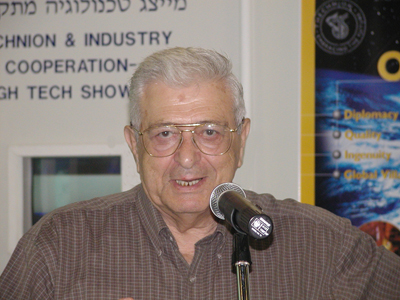We are deeply saddened by the loss of a dear friend. Moshe Zakai, who passed away on November 27 in his hometown Haifa, was an extraordinarily talented man who made a major difference in the life and career of those who collaborated with him as well as many of his students. He was born in 1926 in Sokółka, Poland, and came to Israel (then Palestine) as a child. He is survived by his wife Shulamit (Mita), their children Tamar, Michal and Noam, grandchildren and great-grandchildren.
Zakai obtained his BSc in Electrical Engineering from the Technion – Israel Institute of Technology in 1951. Between 1951 and 1956 he worked at the scientific department of the ministry of defense, as a radar engineer. With a government fellowship, he then did graduate work at the University of Illinois and obtained a PhD in Electrical Engineering in 1958. Upon completion of his PhD, he returned to the scientific department as head of the communication research group. In 1965, he joined the Faculty of Electrical Engineering at the Technion, where he remained throughout his career, retiring in 1998 as a distinguished professor.
Moshe Zakai strongly felt that it was essential to use modern advanced mathematical tools in the study of communication and radar theory. Soon after his PhD he took a keen interest in K. Itô’s stochastic integration theory, and in stochastic differential equations as the proper model for dynamical systems driven by white noise. Shortly thereafter, together with Eugene Wong, he realized that there was a serious obstacle in applying Itô’s theory: white noise is not physical, and Itô’s solution was not continuous in the input (in the sense that driving a stochastic differential equation with an approximation of white noise does not yield a solution that is close to Itô’s solution).
Together, Wong and Zakai, in a ground-breaking 1965 paper, showed how to resolve this problem: an extra term (now called the Wong-Zakai correction) has to be added to the “physical” equation, and with this correction term continuity is restored. This observation opened the door to rigorous applications of the Itô calculus in communication and control on the one hand, and to new developments in the theory of stochastic processes on the other. To some extent, one could interpret Martin Hairer’s recent theory of regularity structures (for which he received the Fields medal in 2014) as a suitable way to introduce Wong-Zakai corrections in the more challenging setup of nonlinear stochastic partial differential equations.
Another topic to which Zakai made a seminal contribution is the theory of nonlinear filtering. Filtering deals with extracting a signal from a noisy observation of it, by computing the conditional distribution of the signal given the observations. In the setup of Gaussian processes, the problem was solved in the 40s by Wiener and Kolmogorov. (It is worthwhile to note that Wiener was motivated by control applications stemming from the WWII effort.) Later, Kalman devised a recursive filter that computed the optimal (linear) filter; Kalman’s filter was a crucial element in the development of modern control, radar and communication systems. However, it did not always approximate well the optimal filter for non-Gaussian models, which is generally nonlinear.
The mid-60’s saw a flurry of activity in addressing this challenge, and various representations of the optimal filter were derived. However, none of those could be computed effectively, as it required solving an infinite system of coupled stochastic differential equations. Zakai’s major insight in his fundamental 1969 paper was to realize that by focusing on an un-normalized version of the conditional density, one could obtain a single bilinear stochastic partial differential equation (the Zakai Equation), from which the filter could be easily computed (and which reduces to the Kalman filter in the Gaussian case). Zakai’s equation has been the basis for all progress in filtering theory; in particular, modern approaches to compute the filter using genetic algorithms (“particle filters”) effectively compute the solution to Zakai’s equation.
After a foray with Eugene Wong into the study of multi-parameter stochastic processes, the last two decades of Zakai’s professional life saw the completion of his transition to a full time probabilist. He turned his attention to the Malliavin calculus which had been introduced by Malliavin in 1979 to study the smoothness of Gaussian functionals—in particular of solutions to Itô equations—with respect to perturbations of the driving white noise, with the aim of providing a probabilistic proof of Hörmander’s criterion for the regularity of solutions of parabolic partial differential equations. Zakai was one of a handful of probabilists who started working on Malliavin’s calculus shortly after its introduction. Very early on, Zakai introduced a different, more geometric, approach summarized in his influential 1985 paper.
His old concern with the continuity of functionals in the underlying white noise resurfaced in 1990 in one of his many joint papers with David Nualart, now in a more abstract setting, which identified the multiple Wiener integrals which are continuous in the Brownian motion. He then embarked with Süleyman Üstünel and others on a program to apply these ideas to the study of anticipative changes of measures on Wiener space. Their joint book from 2000 summarizes the theory and is the standard reference for the study of transformations on Wiener space.
Zakai’s work was recognized by many awards, including the IEEE control society prize and Israel’s Rothschild prize. He was a Fellow of the IEEE, Fellow of the Institute of Mathematical Statistics, foreign member of the US National Academy of Engineering and a member of the Israel Academy of Sciences and Humanities. He was a strong proponent of employing sophisticated mathematical tools in engineering, and showed by example that the interaction between mathematics and engineering is highly beneficial to both disciplines. His voice and mentorship will be sorely missed by his many colleagues, students and friends.
—
Written by Haya Kaspi, Eddy Mayer-Wolf and Ofer Zeitouni

Comments on “Obituary: Moshe Zakai, 1926–2015”